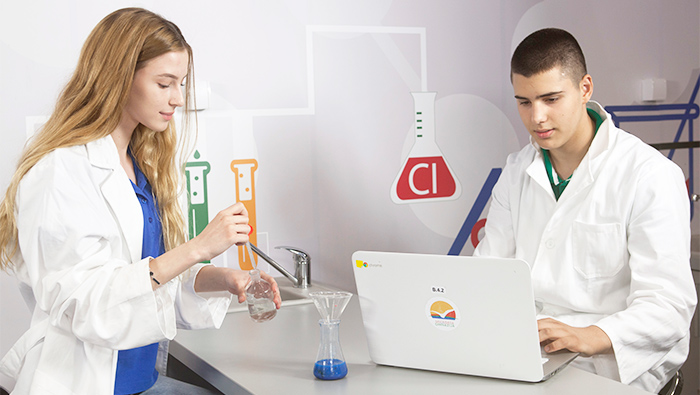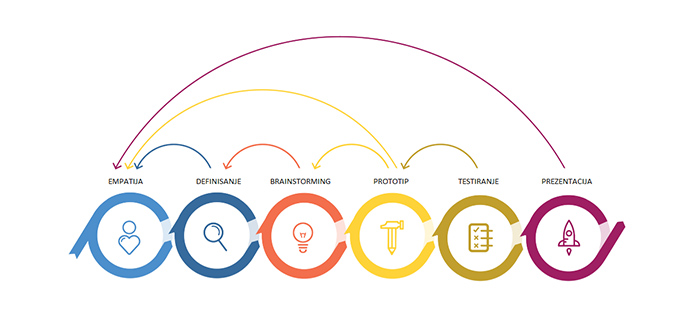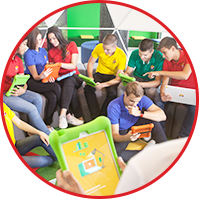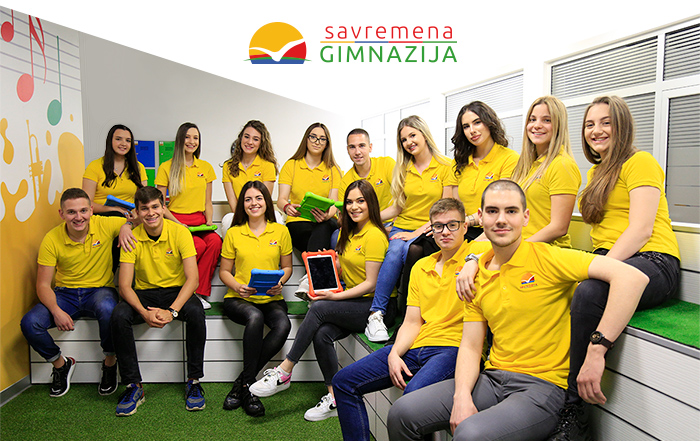DESIGN THINKING AND PROBLEM SOLVING AT SAVREMENA
Innovative learning methods and problem solving in response to the challenges of the 21st century
Design Thinking and Problem Solving is a technique of rational and intuitive thinking based on finding innovative solutions to various problems. It is a creative process that requires empathy and understanding for the needs of the client for whom the solution is designed, as well as the ability to identify and define problems, brainstorm and test solutions and prototypes.
In other words, Design Thinking is an engaged, creative, and user-centred approach to problems in line with the requirements of the digital age and the 21st century. This is why this advanced approach has a special place in education, as it allows students to acquire the skills, abilities and self-confidence needed to live and work in the dynamic world of the future.
Design Thinking is based on man’s inherent, yet teachable ability to be intuitive, recognise patterns, and design ideas that are both emotionally significant and functional.
David Kelley
Students as innovators
Traditional learning required children to prepare for tests and provide correct answers. However, the digital revolution has called this concept of education into question. Nowadays, the answer to almost any question can be found on Google.

Students are expected to be innovative, creative and capable of solving problems. They must adapt to changes and respond to the challenges of the 21st century. The future belongs to such students.
This is why we implement the Design Thinking and Problem Solving model which unlocks students’ creative, cognitive, emotional and social potential.
Design Thinking helps students to:
- develop creativity and self-confidence so as to be able to respond to professional, academic and life challenges;
- take smart risks without the fear of failure and build their determination in problem solving;
- recognise and define problems so as to apply innovative and sustainable solutions;
- learn over and over again using various concepts and hold on to the concept that “no problem is big enough to be solved”;
- understand the value of teamwork and feedback.
This is a process that turns students into innovators.
Design Thinking develops key skills needed to live and work in the 21st century
The need for specific skills that will help students to find their way in times of change and respond innovatively to every challenge has arisen with the development of technology. Design Thinking develops precisely those skills that every individual needs for professional and academic success in the 21st century:
- Creativity and innovativeness
- Critical thinking and problem solving
- Communication
- Collaboration
It is important to note that this is a process that doesn’t restrict students in any way, so their imagination can develop freely.
What does it look like?
For example: instead of telling students to design a car which implies working within a defined framework, they are asked to solve a problem so as to express their creativity without restrictions. In that case, their task becomes to design a means by which actual people will be transported from one place to another. This gives them an opportunity for an out-of-the-box approach which unleashes their innovativeness and leads to major discoveries.
 Another important element of the Design Thinking and Problem Solving model is its emotional component. In other words, instead of solving problems for problems’ sake, students learn to solve problems for the needs of real or imaginary individuals. This way, they become engaged, emotionally invested and more focused. This is particularly important because the modern world is completely user-oriented, i.e. everything is aimed at making the world a better place for everyone.
Another important element of the Design Thinking and Problem Solving model is its emotional component. In other words, instead of solving problems for problems’ sake, students learn to solve problems for the needs of real or imaginary individuals. This way, they become engaged, emotionally invested and more focused. This is particularly important because the modern world is completely user-oriented, i.e. everything is aimed at making the world a better place for everyone.
6 stages of the Design Thinking process

Students with design thinking skills are ready to work with the best
The most successful companies and organisations in the world, such as IBM, Google, Airbnb, Pepsi and Nike, use this innovative method which enables them to achieve exceptional results, and without which modern production and business would be inconceivable.
Research shows that Design Thinking is extremely important nowadays. To be specific:
- companies that implement the Design Thinking approach have higher profits and returns on investment;
- 82% of companies believe there is a strong link between creativity and business;
- 71% of organisations that implement Design Thinking emphasise that this approach improved teamwork and communication.
Because of all this, the largest global companies hire candidates who possess Design Thinking and Problem Solving skills, and this is where the education system comes in.
The best schools in the world use Design Thinking and Problem Solving to prepare their students for the future
The modern age requires modern approaches, and success in the 21st century no longer means one should be a walking, breathing encyclopaedia, but instead, to be able to use their knowledge in an innovative, creative and attainable way, thus pushing boundaries. This is why some of the most prestigious educational institutions in the world have been implementing this unique method at all levels of education.
The Design Thinking and Problem Solving approach is particularly important in schools, because if students practice critical thinking, creativity, innovativeness, and determination in problem solving, they will grow into true 21st-century students who can readily face any challenge of the modern age.
Because of all this, Design Thinking and Problem Solving is one of the fundamental approaches in the best schools in the world.
Have a look at one Design Thinking and Problem Solving lesson at Savremena
Every lesson is carried out in several Design Thinking stages during which students solve specific, challenging, and engaging problems. Check out how much Savremena Gimnazija students enjoy this adventure of learning and research.
1. Empathy
 This is often the most important stage that determines the extent of student interest and motivation. If carried out correctly, other stages are far easier. Concrete examples are used to arouse empathy. For example, during a mission to Mars, the spacecraft that was supposed to return the astronauts back to Earth broke down. The students’ task is to find a way to provide the crew with food and water while the craft is being repaired. Thanks to educational technology, children are able to see the astronauts’ faces, they get to know their names, and learn about their families and hobbies, thus forming an emotional attachment which increases their motivation to solve the problem and help these people.
This is often the most important stage that determines the extent of student interest and motivation. If carried out correctly, other stages are far easier. Concrete examples are used to arouse empathy. For example, during a mission to Mars, the spacecraft that was supposed to return the astronauts back to Earth broke down. The students’ task is to find a way to provide the crew with food and water while the craft is being repaired. Thanks to educational technology, children are able to see the astronauts’ faces, they get to know their names, and learn about their families and hobbies, thus forming an emotional attachment which increases their motivation to solve the problem and help these people.
2. Problem definition
 After getting acquainted with the astronauts and their needs, students must clearly articulate the problem they need to solve. This is a very important step, because the proposed solutions directly depend on it. In other words, students need to take into account all the circumstances: time the astronauts have at their disposal, remaining food and water supplies, and the possibility of transferring additional food and water by means of special spacecraft and robots.
After getting acquainted with the astronauts and their needs, students must clearly articulate the problem they need to solve. This is a very important step, because the proposed solutions directly depend on it. In other words, students need to take into account all the circumstances: time the astronauts have at their disposal, remaining food and water supplies, and the possibility of transferring additional food and water by means of special spacecraft and robots.
3. Brainstorming
 This is often the most enjoyable stage, because students enjoy proposing different solutions for a specific problem, and their imagination knows no boundaries. It is important to note that this is a group activity where students share their suggestions with one another. To make brainstorming successful, the following guidelines should be followed:
This is often the most enjoyable stage, because students enjoy proposing different solutions for a specific problem, and their imagination knows no boundaries. It is important to note that this is a group activity where students share their suggestions with one another. To make brainstorming successful, the following guidelines should be followed:
- avoiding judgment of other people’s opinions
- proposing as many different ideas as possible
- complementing other people’s ideas
- maximum creativity.
4. Prototype
 After agreeing about the solution they want to implement, students begin building a prototype. For example, using LEGO STEM building sets, students can build spacecraft for transporting tools to Mars, by using levers and gears, they can repair the damaged spacecraft, by programming mini robots, they can transport the necessary supplies to the crew, etc.
After agreeing about the solution they want to implement, students begin building a prototype. For example, using LEGO STEM building sets, students can build spacecraft for transporting tools to Mars, by using levers and gears, they can repair the damaged spacecraft, by programming mini robots, they can transport the necessary supplies to the crew, etc.
5. Testing
 The teacher goes from one group to another, asking questions about the prototype to make sure the solution is functional and effective. Students often notice the defects of the proposed solution on their own during this stage, and fix the prototype.
The teacher goes from one group to another, asking questions about the prototype to make sure the solution is functional and effective. Students often notice the defects of the proposed solution on their own during this stage, and fix the prototype.
6. Presenting the solution
 Each team then has the task of presenting the solution they have come up with in an engaging, emotional and comprehensible way. This is the final stage that allows students to develop their skills of presentation, persuasive communication, and the ability to speak in front of a crowd.
Each team then has the task of presenting the solution they have come up with in an engaging, emotional and comprehensible way. This is the final stage that allows students to develop their skills of presentation, persuasive communication, and the ability to speak in front of a crowd.
Students of Savremena Gimnazija – Future innovators, artists and problem solvers
In line with the latest educational trends, Savremena Gimnazija implements the problem solving methodology in teaching. The Design Thinking and Problem Solving concept implemented at Savremena allows them to freely develop all their talents in an encouraging and supportive environment, and to learn to utilize their full potential.
Students are given various case studies to solve with problem-oriented thinking, thus learning to use problem solving in everyday life and work, and to think in line with its principles. Unlike traditional tasks and tests, in problem solving, there is always more than solution. It involves a combination of different approaches and corresponds to different learning styles, which is why it goes well with the multiple intelligences method.
Problem solving is nowadays considered to be the most effective teaching method for student development where they get the tools for solving various problems independently and creatively. It arose from the idea of overcoming traditional curricula, because traditional tests and written assignments often prevent the development of these skills to their full extent. This is why the most successful teaching practices in the world make use of problem solving.
Enable your child to get an education in line with the latest global trends.



















